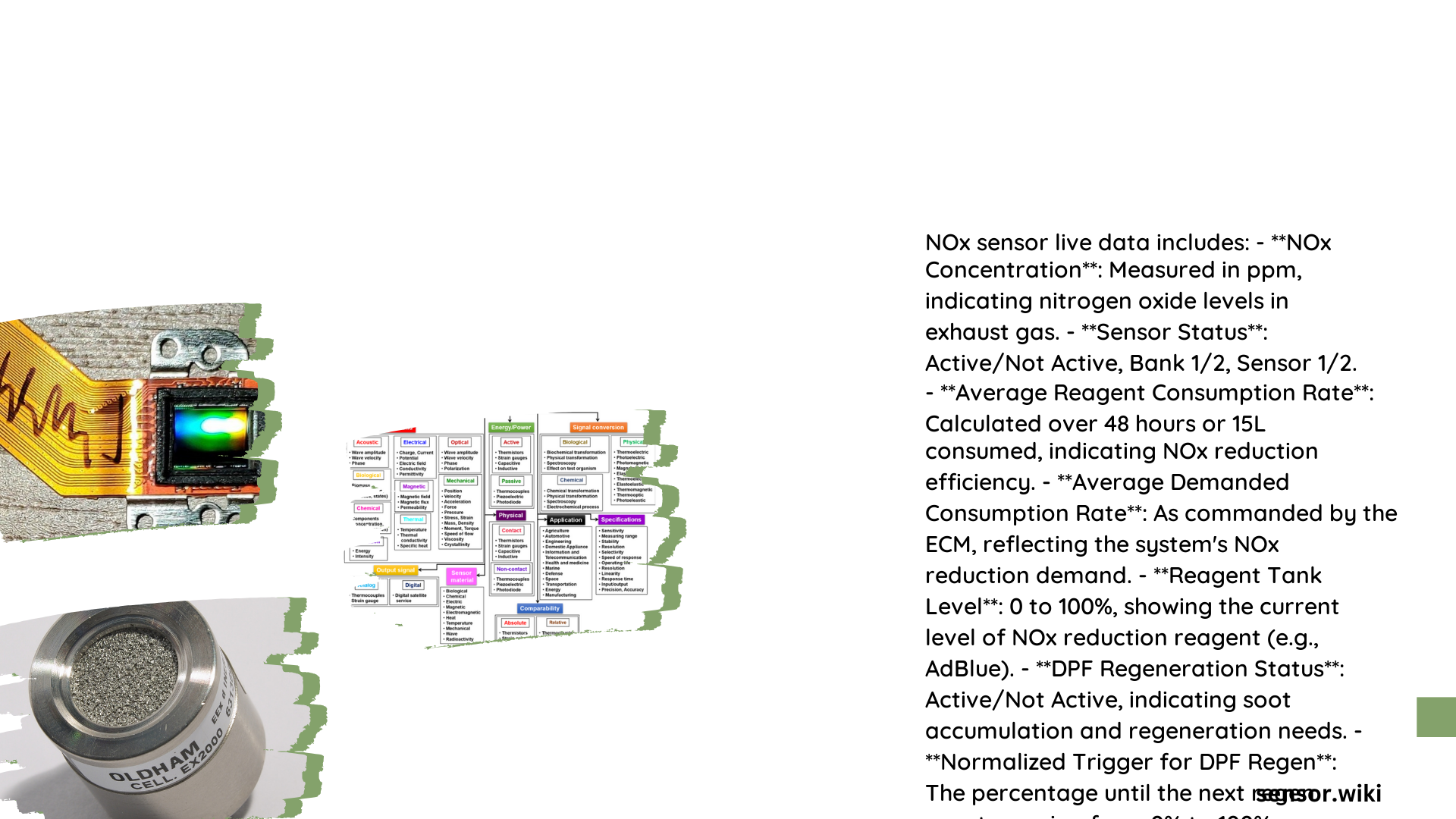NOx sensor live data refers to the real-time information collected and transmitted by nitrogen oxide (NOx) sensors in vehicle exhaust systems. These sensors play a crucial role in monitoring and controlling emissions, ensuring compliance with stringent environmental regulations. NOx sensors provide immediate feedback to the engine control unit (ECU), allowing for precise adjustments to the engine and selective catalytic reduction (SCR) system. This live data is essential for maintaining optimal vehicle performance and reducing harmful emissions.
What are the Key Components of NOx Sensor Live Data?
NOx sensor live data comprises several critical components that work together to provide accurate and timely information about exhaust emissions:
- NOx concentration measurements
- Temperature readings
- Oxygen level detection
- Diagnostic information
- Error codes and warnings
These components collectively enable the vehicle’s systems to make real-time adjustments and ensure proper emission control.
How Does NOx Sensor Live Data Streaming Work?

NOx sensor live data streaming involves a complex process of data collection, transmission, and interpretation:
- Data Collection: The sensor continuously monitors the exhaust gases, measuring NOx concentrations and other relevant parameters.
- Signal Processing: Raw data is processed within the sensor to filter out noise and ensure accuracy.
- Data Transmission: Processed data is sent to the ECU using automotive communication protocols.
- Interpretation: The ECU analyzes the received data and makes necessary adjustments to engine operation and emission control systems.
- Feedback Loop: The process repeats continuously, creating a real-time feedback loop for optimal performance.
What are the Performance Metrics for NOx Sensor Live Data?
Understanding the performance metrics of NOx sensor live data is crucial for evaluating its effectiveness:
Response Time
- Fast response times are essential for real-time monitoring and control.
- Specific response times vary by sensor model but are generally in the millisecond range.
Detection Limits
- Typical detection ranges:
- 0 – 3000 ppm for commercial NOx sensors
- 0-500 ppm for passenger car applications
Accuracy
- High accuracy is critical for compliance with emissions regulations.
- Exact percentages vary by sensor model and manufacturer.
Data Streaming Rates
- While specific Hz rates are not typically specified, NOx sensors provide continuous real-time measurements.
Latency
- Minimal latency is crucial for timely adjustments to engine and SCR systems.
- Exact latency values are not commonly published but are designed to be as low as possible.
What Challenges Affect NOx Sensor Live Data Integrity?
Several factors can impact the integrity of NOx sensor live data:
- Soot Buildup: Accumulation of soot from the combustion process can damage sensors over time.
- Temperature Fluctuations: Sensors must operate within a specific temperature range (-40°C to 800°C) for optimal performance.
- Humidity and Water Exposure: While sensors are designed to be water-resistant, extreme conditions can affect performance.
- Sensor Aging: Over time, sensors may degrade, affecting data accuracy.
- Calibration Drift: Regular calibration checks are necessary to maintain accuracy.
How is NOx Sensor Live Data Used in Vehicle Management?
NOx sensor live data plays a vital role in various aspects of vehicle management:
- Emission Control: Real-time data allows for precise adjustments to reduce NOx emissions.
- Engine Performance Optimization: Data helps fine-tune engine operation for efficiency.
- Diagnostic Functions: Live data aids in identifying and troubleshooting issues.
- Regulatory Compliance: Ensures vehicles meet emission standards during operation.
- Maintenance Scheduling: Helps determine when sensor replacement or system maintenance is needed.
What are the Cost Considerations for NOx Sensor Live Data Systems?
When implementing NOx sensor live data systems, several cost factors come into play:
Hardware Costs
- Sensor prices vary by model and manufacturer.
- High-quality sensors like the ZFAS®-N2 / EGS®-NX are more expensive than basic models.
- Approximate weight: 300 g for some models.
Software and Integration Costs
- While not typically a separate expense, integration with vehicle management systems may incur costs.
Maintenance Expenses
- Regular checks and potential replacements due to wear and tear.
- Costs can increase with inadequate engine maintenance.
Replacement Cycles
- Sensors may need replacement during the vehicle’s lifetime.
- Frequency depends on usage conditions and maintenance practices.
How Does Environmental Conditions Affect NOx Sensor Live Data?
Environmental factors can significantly impact NOx sensor live data quality:
- Temperature: Sensors operate optimally between -40°C to 800°C.
- Humidity: High water resistance is built-in, but extreme conditions may affect performance.
- Exhaust Gas Composition: Variations in exhaust gases can influence sensor readings.
- Vibration and Shock: Sensors must withstand typical vehicle vibrations without data degradation.
- Altitude: Changes in atmospheric pressure at different altitudes may require calibration adjustments.
What Future Developments are Expected in NOx Sensor Live Data Technology?
The field of NOx sensor live data is continuously evolving:
- Increased Accuracy: Development of sensors with even higher precision.
- Extended Lifespan: Innovations to prolong sensor operational life.
- Broader Detection Range: Sensors capable of measuring a wider range of emissions.
- Integration with AI: Advanced data analysis for predictive maintenance and performance optimization.
- Miniaturization: Smaller sensors with improved performance characteristics.
In conclusion, NOx sensor live data is a critical component in modern vehicle emission control systems. As environmental regulations become more stringent, the importance of accurate, real-time NOx monitoring will only increase, driving further innovations in sensor technology and data management systems.
